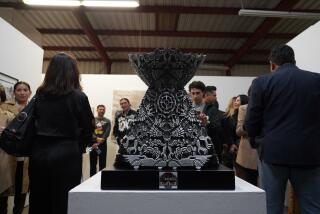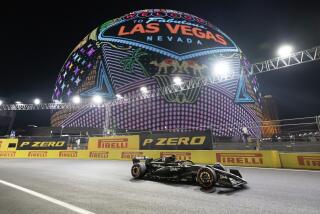A grease geek will guide you: ‘Cars’ decoded
“CARS” is the “Da Vinci Code” for gear heads.
Sure, you can enjoy Pixar’s shiny new hotrod of a summer movie without a lot of expert car knowledge. Oh, but it helps. The movie, which lands in theaters Friday, is up to its wiper blades in esoteric racing references, inside jokes, lug nut lore and automotive minutiae, the sort of stuff that will go right over the heads of most people but will make your local ASE-certified mechanic pee his pants.
For instance: The film is set in Radiator Springs, a bypassed little town on Route 66, where our anthropomorphic hero, Lightning McQueen -- unexpectedly sidetracked on his way to the big Piston Cup season finale -- learns a standard-issue Lesson About Life. The local watering hole is Flo’s V8 Cafe (a drive-in), the neon lights for which -- get this -- flash in the proper cylinder firing order of an old Ford flathead V8 engine.
Got geek?
“That was all [character manager] Jay Ward,” says director John Lasseter. “He is the resident guru for all things automotive.” In fact, the “Cars” production team consulted a long list of automotive experts -- designers, racers, transportation historians and engineers -- to bring a level of verisimilitude unusual, one might even argue not absolutely necessary, to a movie about, you know, talking cars.
What follows then is a short list of automotive references in the movie and their explanations, which will help vehicularly disadvantaged cineastes understand what, exactly, the guys in overalls are cackling about.
Marbles: You know the moviemakers have it bad if they go to the trouble of getting the dirt right. In the race sequences, we see clouds of little black balls being swept along the racetrack. These are “marbles,” bits of tire that get shed from race cars and pill together on the outside of the racing line. They are very slippery and cause crashes, giving stock-car racing one of my personal favorite phrases: “Yep, he done got into them marbles.” They have marbles in Formula 1 racing too, but they are pronounced “mahh-bels,” as in: “Those mahh-bels are a spot of bother, eh wot?”
“The Big One”: As the saying goes, wrecks are only funny until somebody gets hurt, and then they are hilarious. Wrecks have a history and connoisseurship all their own. And so, in the opening race sequence, you see a re-creation of a famous wreck, the huge, accordion-style pileup that occurred at Talladega in 2005, a.k.a. “the Big One,” which damaged or retired 25 cars. In point of fact, the Big One is a type -- a genre, if you will -- of chain-reaction accident that looms over every superspeedway event.
The reason? Race organizers, in an effort to keep speeds down, on these monster tracks, fit the cars with restrictor plates in their carburetors. The problem with “restrictor-plate racing” is that the cars bunch up as they all reach their top speed together. This sets the stage for the Big One, which can take out dozens of cars, some in the initial incident and others as they drive into the blinding cloud of smoke and crashed cars.
Speaking of wrecks, the walloping end-over-end crash of “the King” at the end of the movie is a virtual frame-by-frame re-creation of Rusty Wallace’s famous end-o at Talladega in 1993 when his car flipped 23 times. Remember that? Rusty doesn’t.
Piston Cup: This is not so esoteric. The prize that Lightning seeks is a sound-alike for Winston Cup, which for decades was the name of stock-car racing’s premier series and championship trophy -- sponsored by a certain brand of cigarette that, as the advertising slogan ran, “Tastes good” like cancer-causing, restaurant-polluting death sticks should. The sponsorship of the cup changed hands three years ago to the intensely yuppified “Nextel Cup.”
Lightning: Young children may turn hopefully to their NASCAR dads to ask, “What kind of car is Lightning McQueen?” To which the response might be, “Ummm ... “ And so the slow downward spiral of parental respect will begin.
As it turns out, Lightning is no particular kind of car. “Due to aerodynamics, the shape of NASCAR cars is relatively flat,” says Lasseter, “and not very interesting.” Lasseter and his team designed McQueen as a hybrid between a stock car and a more curvaceous Le Mans endurance racer, says Lasseter, “with some Lola and some [Ford] GT40.” Keen observers of the sport will note, however, that McQueen’s rear spoiler is in “short-track” configuration -- tall and upright -- even though he’s racing on superspeedways. (If you know this, you have pegged the Foxworthy meter: You might be a redneck.)
Unlike real stock-car racing, in which all the cars are virtually identical, “Cars” puts race cars from different eras on the same track. Thus you have Lightning racing against “the King,” a 1970 Plymouth Superbird -- the animated avatar of racing legend Richard Petty, who also provides the voice talent. The heavy in the script is Chick Hicks, whose character design is reminiscent of “The Intimidator,” the late Dale Earnhardt. Specifically, Chick looks like Earnhardt’s 1979 Pontiac Ventura with green-and-blue Wrangler livery. If you know this, you done spun the Foxworthy meter off its spindle.
Doc Hudson: Something for old schoolers. Radiator Springs’ cranky but beloved judge is Doc, a ’51 Hudson Hornet, who we learn was once a famous race car. Indeed, it was. Thanks to its powerful 308-cubic-inch engine and low center of gravity, the “Fabulous Hudson Hornet” dominated stock-car racing in the early 1950s, with 80 wins in four years. Hudson’s most famous shoe was Marshall Teague, who -- like the Doc character in the film -- walked away from stock-car racing not because of a crash but due to a dispute with Bill France Sr., NASCAR’s gun-toting impresario. Bonus points if you know that Paul Newman, who provides the voice of Doc, is an accomplished racer; even more bonus points if you know he played the title role in a movie called “Hud.” And, yes, the car has blue eyes.
Oversteer: The movie’s story turns on Lightning learning an old racing trick from his adopted mentor, Doc: Turn right to go left. This refers to what is known in competitive driving as counter-steering or “opposite lock.” To maintain speed around a corner, drivers will force the car’s rear end to fishtail to the outside while steering in the direction of the slide. The car will arc around the corner in a controlled four-wheel drift, literally turning right to go left. A reality check: This trick works well on dirt and gravel but on asphalt it tends to result in piles of very used auto parts.
Driver cameos: In the film, famous race-car drivers provide voice cameos. Three-time Winston Cup winner Darrell Waltrip costars as the excitable announcer, Darrell Cartrip. Petty, of course, is the King. NASCAR rock star Dale Earnhardt Jr., Mario Andretti and even seven-time F1 world champion Michael Schumacher make an appearance. “Schumacher was great,” says Lasseter. “He did his lines in English, German and Italian.” Interestingly, because Petty has a relatively minor following in, say, Finland, the cast of voices changes as the film is dubbed for other countries. For Germany, the King is voiced by three-time F1 champion Niki Lauda. In Spain, F1 ace Fernando Alonso steps into those fireproof shoes.
Radiator Springs: In 2001, Lasseter and members of his creative team loaded up in four white Cadillacs for a nine-day cruise along parts of Route 66, the famous Mother Road between Chicago and Los Angeles, the Oregon Trail of American auto-mobility. The architecture of Radiator Springs is drawn from the postcard folk-art structures along Route 66. The Cozy Cone Motel, a collection of huts that look like orange traffic cones, was inspired by tepee villages such as the Wigwam Motel in Holbrook, Ariz., which won no awards for cultural sensitivity.
Even the mountains that loom over Radiator Springs are inspired by Route 66. The Cadillac Range, a series of red-rock promontories that look like the baroque tailfins of late-’50s Caddies, was inspired by the Cadillac Ranch, the kitsch-art installation on Route 66 near Amarillo, Texas, where a row of the cars are submerged nose-first in the ground. Insert GM joke here.
For as closely observed as the “Cars” universe is, the happy ending might ring a little false with racing fans, when Lightning turns down the big sponsorship deal to stay with his small-time backers, Rust-eze Bumper Ointment. In the bottom-line, money-equals-speed world of NASCAR, that ain’t gonna happen.
More to Read
Only good movies
Get the Indie Focus newsletter, Mark Olsen's weekly guide to the world of cinema.
You may occasionally receive promotional content from the Los Angeles Times.










